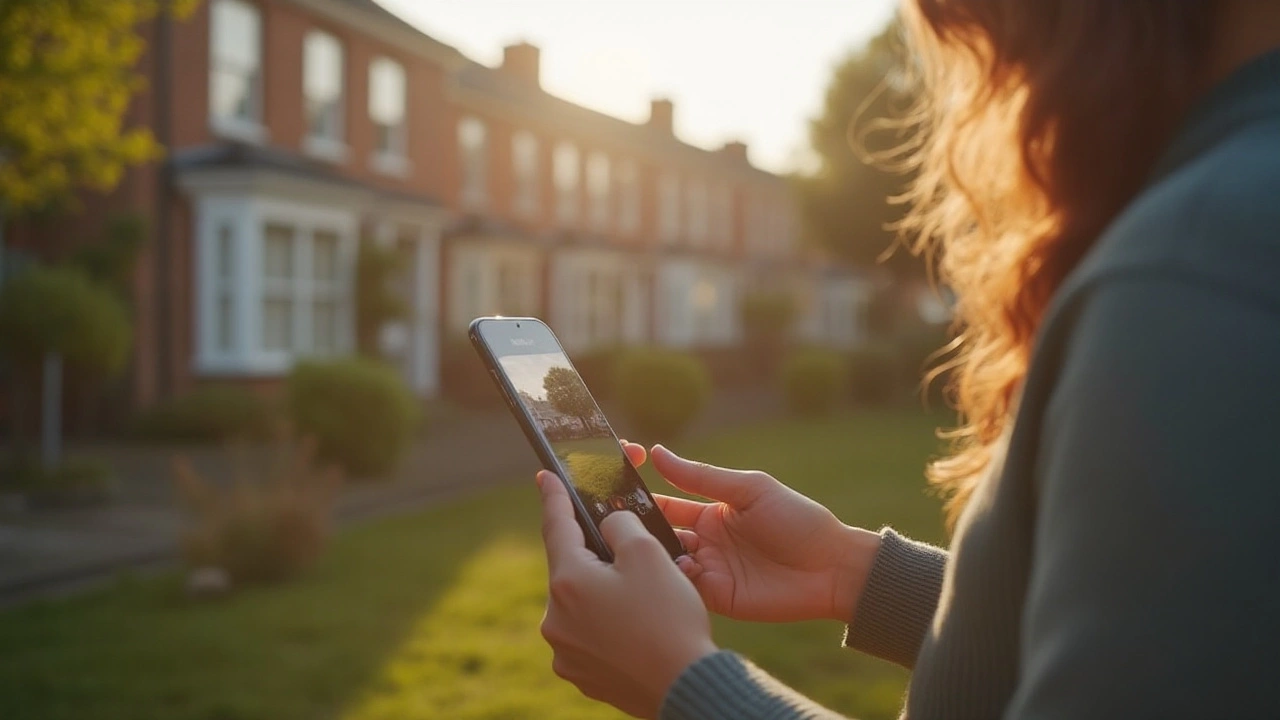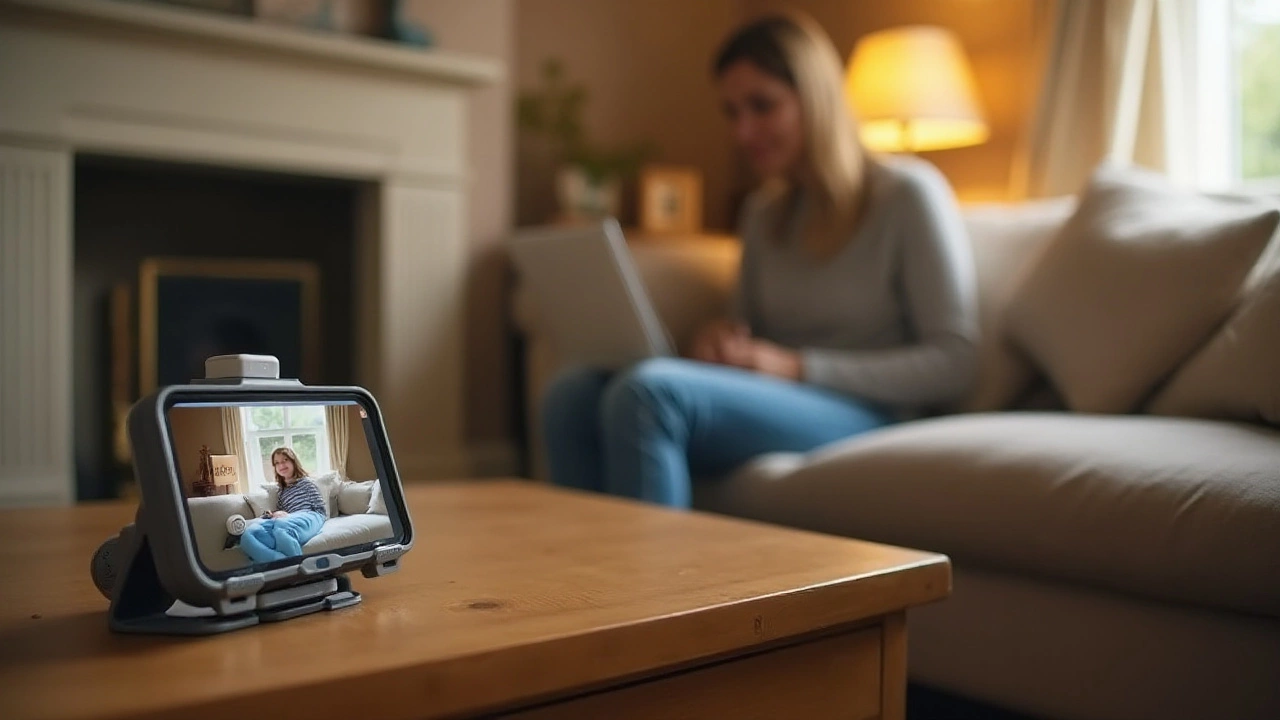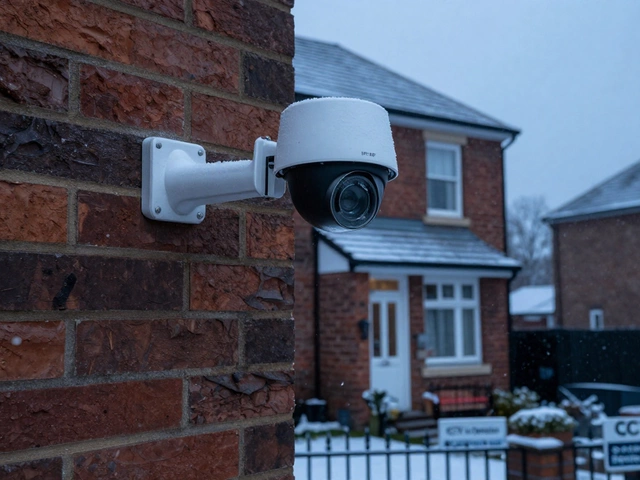In today's tech-savvy world, keeping an eye on your baby while juggling day-to-day tasks has never been easier, thanks to the magical combo of smartphones and baby monitors. The idea is simple: connect your phone to your baby monitor, and voila! You have a portable portal to your little one's world, right in your pocket.
But wait—how does one make this seamless connection happen without turning into a techno-wiz overnight? Fear not, because this guide is here to help you get there with just a few taps and swipes. We’ll explore the different types of baby monitors, their compatibility with smartphones, and provide tips to integrate them with your daily routine like clockwork.
Connecting your phone to a baby monitor not only enhances convenience but also adds layers of security, letting you ensure that your little bundle of joy is safe and sound, anytime and anywhere. Let's dive into how you can make this happen effortlessly and discover some perfect monitor options that are out there for you.
- Understanding Baby Monitor Types
- Compatibility with Smartphones
- Setting Up Your Device
- Security and Privacy Considerations
- Troubleshooting Common Issues
- Top Picks for Smartphone-Compatible Monitors
Understanding Baby Monitor Types
In the world of baby monitors, diversity is vast, catering to various parental needs and technologies at hand. Whether you are a tech enthusiast or prefer simplicity, understanding the types of monitors can guide you in making the best choice. There are three main categories: audio monitors, video monitors, and sensing monitors. Each has unique features that cater to different parental preferences.
Audio Monitors
Audio monitors are the descendants of the traditional 'walkie-talkie' style gadget. They transmit sound from the baby's room to a receiver carried by the parent. Embracing simplicity, these devices have limited technological interference, great range, and, notably, the least power consumption. An interesting feature in some advanced models includes the ability to pick up ambient sound and noise from the baby's room, automatically adjusting volume levels for clearer listening.Consider this: in a situation where you’d prefer not to have invasive monitoring, an audio option could be ideal. Still, the landscape has changed dramatically from the audio-only days, leading us to our next stop, video monitors.
Video Monitors
When it comes to watching over the little one, many parents opt for the reliability of video monitors. These devices offer the added benefit of visual contact allowing you to see your baby as well as hear them. Equipped with night-vision capabilities, they ensure 24-hour video monitoring, granting you some peace in observing the gentle rise and fall of your baby's breathing.Video monitors often connect with smartphones, enabling streaming directly to your phone when using compatible apps. While slightly more complex, they provide a more holistic view of what's going on. With today’s technology, high-definition monitors are an unarguable game-changer. Who knew that watching a sleeping baby could be so engaging!
Sensing Monitors
Enter the advanced realm with sensing monitors. These devices monitor the baby’s movement and breathing patterns. Designed to detect irregular activities, they can alert parents to potential concerns that require immediate attention. The most sophisticated models can be a blend of both audio and video functions, with sensors that analyze a baby's physical reactions.A pertinent quote by Emily Oster, an economist and parenting author, encapsulates parental trust in tech:
"Technology is not a substitute for parenting, but when used wisely, it can add layers of monitoring and comfort."In deciding the best monitor for your needs, reflect on what brings you peace of mind. Whether you prefer simple audio features or need comprehensive monitoring, there is a perfect option to suit you.
To further understand, it might help to visualize differences between these types in the following breakdown:
| Type | Feature | Best For |
|---|---|---|
| Audio | Sound Alerts | Basic Needs |
| Video | Visual & Audio Monitoring | Comprehensive Monitoring |
| Sensing | Breathing & Movement Monitors | Health Concerns |
By understanding these variations, you can significantly enhance the selection process when looking for a baby monitor that connects to your phone. Embrace the art of electronic babysitting with knowledge, and find comfort knowing you've picked the best companion for your parenting journey.
Compatibility with Smartphones
When it comes to hooking up your trusty smartphone with a baby monitor, understanding compatibility is where most parents find themselves navigating the tech landscape. It’s essential to check not only the type of monitor but also how it communicates with your phone. Most modern baby monitors connect either through Wi-Fi or Bluetooth, each with different implications on how you’ll use the device daily. Many baby monitors offer apps designed specifically for iOS or Android, making it clear which phones they're compatible with. For those using a mix of devices, dual compatibility is key — nothing’s worse than regretting a purchase because it only syncs with Mom’s phone and not Dad's.
Wi-Fi enabled baby monitors tend to provide more features — such as remote video streaming even when you’re out of the house — compared to their Bluetooth counterparts, which usually work within a limited range. These Wi-Fi monitors can turn your phone into a full-fledged surveillance tool, offering peace of mind on the go. However, they require a strong and stable internet connection, so if your Wi-Fi has a history of dropping signals, it might not be the best choice. This feature essentially lets anxious parents or caregivers pop in virtually at any hour, without needing to be physically present.
It’s interesting how some brands have set themselves apart by offering high-level encryption to protect these transmissions. As per a 2023 report from Digital Safety Platform, 78% of parents are more likely to choose monitors with enhanced security features that safeguard data integrity across the connection. Not to mention, these features are relatively easy to set up, requiring just a free app download and a few permissions for camera and microphone access on your device.
"In our rapidly evolving tech world, expecting enhanced connectivity standards while also prioritizing security has become imperative," notes Jane Thompson, a leading technology analyst. "Parents should be encouraged to explore and choose baby monitors that align seamlessly with their current tech ecosystems."
Platform-Specific Apps
For parents, the convenience of an app often makes all the difference, especially those developed by the monitor manufacturers themselves. These apps usually provide extensive control over monitoring settings such as video resolution, alert notifications, and data sharing options. It's a common sight these days to find these apps supporting features like temperature monitoring, sleep tracking, or even lullaby playlists, specially customized across different brands and models. The major platforms like Apple and Google Play Stores become allies, offering up-to-date versions to ensure no tech glitch becomes a parental headache.
When scoping out potential monitors, it is worth visiting these app stores and skimming through ratings and reviews. This can offer insights into both performance issues and unexpected boons of certain systems, especially when users share their experiences. Diving into this realm helps parents understand user-friendliness while tackling emerging complexities capable of suddenly charging into parenthood.
Last but not least, checking out manufacturer support pages answers additional questions specific to each model's connectivity architecture — a crucial step for ensuring both software compatibility and avoidance of technical misadventures. Before investing, always remember that the key to a happy tech household often lies in the harmonious coexistence of existing devices with the rest of your smart home ecosystem.

Setting Up Your Device
Diving into the world of baby monitors can feel a lot like opening Pandora's box, but setting them up isn't as daunting as it seems. The first step in connecting your smartphone to your baby monitor is understanding the technology that's inside it. Most modern monitors come with Wi-Fi connectivity, allowing you to link them to a dedicated app on your smartphone. This lets you watch over your child even when you're out of the room, making it crucial to match the monitor's features with your smartphone's capabilities. You'll need to download the correct app for the monitor, usually available through the Google Play Store or Apple App Store. Once the app is installed, follow its guided instructions to establish a connection between the monitor and your phone. This step typically involves scanning a QR code or entering a unique code found in the monitor's packaging.
Next, ensure your Wi-Fi network is stable and has a strong signal in the baby’s room. The monitor relies on your home's internet connection to relay its video and audio feed to your smartphone. Check if your Wi-Fi router suffices or consider a Wi-Fi extender if your home has spotty coverage. Once you've nailed these basics, it's time to sync the devices. Most monitors require Bluetooth pairing initially, which transitions to Wi-Fi for streaming purposes. During pairing, the app and monitor will communicate, allowing you to define settings like motion detection sensitivity or two-way audio. Many parents find features such as zooming or night vision handy, and these require a stable connection to function seamlessly.
Let's not forget the privacy aspect when setting up your smart devices. Always change default passwords to better secure your baby monitor against hackers. A report by Consumer Reports highlighted the necessity of updating the firmware regularly to patch security vulnerabilities. Enable encryption through the app settings if available, adding another protective layer. If any connection hiccups arise, you may benefit from rebooting your devices or even reinstalling the app, as software updates often resolve underlying technical glitches.
"For parents looking to blend convenience with peace of mind, smartphones prove a revolutionary tool when paired with a baby monitor," notes James Toombs, author of 'Smart Parenting in a Digital Age'.
Now onto personalizing the experience, where parents can curate settings like audio alerts or customized notifications for movement, all controlled via their phone. This helps you maintain a tranquil environment without unnecessary disturbances. You want everything on your phone as intuitive as flipping a light switch, yet complete when it comes to coverage, whether you are in the next room or out for a stroll. By following setup instructions and exploring app features, the baby monitor transforms into a truly multifunctional gadget integrated with your lifestyle. Streamline these steps effectively to ensure you're ever connected and always aware, translating to a calm household where both you and your little one thrive.
Security and Privacy Considerations
When it comes to connecting your baby monitor with your smartphone, security and privacy should be right at the forefront of your mind. After all, we’re talking about safeguarding precious moments and ensuring sensitive family information remains just that—sensitive. In today's digital age, the convenience of monitoring your baby's room from your phone can sometimes come with the risk of unauthorized access. This is why choosing a monitor with robust security features is essential. You’d want to opt for systems that have secure encryption protocols such as WPA2 or newer, which essentially act like a fortress for your data, keeping unauthorized folks at bay.
Using a strong, unique password is another layer of security that's often overlooked but tremendously effective. Changing the default login credentials is a must, and routinely updating them adds an additional shield against potential breaches. Parents might find it helpful to set reminders to change these passwords periodically.
Encryption and Secure Connections
The choice of network is crucial when linking your phone and monitor. Public networks, tempting as they may be when you're out and about, generally lack strict security, making connections easy targets for hackers. Sticking to private, well-secured networks at home significantly reduces the chances of anyone snooping around. A Virtual Private Network (VPN) can offer an extra layer of protection by encrypting your data traffic, essentially disguising your online activities from any prying eyes.
If you’re worried about eavesdropping when your baby monitor is connected to the internet, devices equipped with FHSS technology (Frequency-Hopping Spread Spectrum) provide a more secure option. These constantly change frequencies in a coded manner, making intercepting signals very difficult. One parent I spoke to said, "Choosing a baby monitor with FHSS was a game-changer, it gave me peace of mind knowing my family’s privacy was intact."
Regular Software Updates
Routine updates are not just about new features; they often patch up security flaws. Manufacturers release updates to safeguard against the ever-evolving cyber threats. Make it a point to update both your baby monitor’s firmware and the app on your smartphone. Failing to do so, it’s like leaving the front door open to the internet’s bad guys.
Monitor and Evaluate Permissions
The app permissions you grant should be scrutinized if you’re linking your smartphone to your baby monitor. Some apps request access to data and features that aren’t necessary for them to function, like your contact lists or location. Denying these unwarranted requests can minimize potential exposure. Review these permissions regularly, and revisit the terms and conditions to fully understand what parts of your data are being used.
For those keen on maintaining vigilance, setting up monitoring alerts can’t hurt. Many devices offer features such as notifications for unusual activity or failed login attempts. These neat alerts help you stay on top of what’s happening and act swiftly if something suspicious is afoot.

Troubleshooting Common Issues
Connecting your baby monitor to your smartphone can be a blissful blend of technology and convenience, but like any tech duo, it can sometimes hit snags. First, you might encounter connection problems—possibly due to Wi-Fi interference or device incompatibilities. It's crucial to ensure your baby monitor and phone are on the same network. If they're not singing in harmony, first try restarting your router and the monitor. Keep in mind, many monitors need a robust internet connection, meaning homes with weak Wi-Fi signals might need a booster or relocate the setup for better reception.
If connecting through an app, it's always worthwhile to check for updates. Often, developers push updates to address common bugs and improve app compatibility with various smartphones. Occasionally, app crashes can stem from software incompatibility, especially if your phone's operating system is lagging in updates. Ensuring both your app and OS are current can save a heap of hassle. And don’t shy away from exploring the forums or manufacturer FAQs; other users might have battled similar issues. According to a report by Tech For Parents Weekly, “Over 40% of baby monitor app issues are solved by a simple app update or reinstallation.”
Security concerns are another problem area. Many parents understandably fret about potential privacy breaches. Always make sure that your baby monitor comes with robust encryption standards. Changing default passwords and regularly updating them can shield you from unwanted cyber intruders. Some parents opt to disable remote access when not needed, which adds another security layer. If you suspect any breach, reset your credentials immediately and check for any irregular logs or connections. Embracing multi-factor authentication, if available, can be a smart move too.
At times, sound or video lag might be a thorn. This can happen due to network congestion or insufficient bandwidth. Closing unused applications and disconnecting other devices from the network may help to free up bandwidth. If video quality frequently downgrades, adjusting the settings from HD to SD in low-speed scenarios is a workaround. A bit of detective work on your network usage can provide insight into potential culprits and guide a fix.
A persistent issue for some can be the dreaded false alarms from noise sensors, a problem often occurring due to uncalibrated sensitivity settings or external noises. Adjusting these to fit your environment can significantly cut down on the disruptions. In some rare cases, background noise from fans or humidifiers might trigger unnecessary alerts - experimenting by temporarily moving or turning off these devices can help eliminate the problem.
For those who find persistent issues overwhelming, contacting customer support can sometimes unearth solutions quickly. Armed with model numbers and a clear description of the problem, these teams can provide invaluable guidance. Remember, the goal is not just to have cutting-edge technology, but also to enjoy the peace of mind it promises. Frequent and clear communication with your support team can lead to timely resolutions.
Top Picks for Smartphone-Compatible Monitors
When diving into the world of baby monitor options that harmonize with your smartphone, there are a few standout models that promise both convenience and cutting-edge features. Choosing the right model is crucial for ensuring you don’t just get a basic view of your child's room but also real-time updates, crisp video quality, and reliable security features.
One must-have on the list is the Nanit Pro Smart Baby Monitor. Renowned for offering exceptional video quality, this monitor streams real-time 1080p HD video right to your smartphone, allowing you to stay connected with your little one from anywhere. The added bonus is its sleep insights feature, which provides you with detailed, data-driven insights into your baby's sleep patterns, helping you understand and improve their sleep for better health outcomes. A Hub of Innovation even described it as "more than just a monitor, it's peace of mind in a box."
Nanit’s comprehensive design focus bridges the gap between technology and parenting, revolutionizing how new parents care for their babies.
Another top contender is the Motorola Halo+, which is beloved for its ease of use and unique functionality. This smart monitor connects seamlessly with its mobile app, providing a vivid HD display along with a two-way voice feature so you can talk to your baby even when you're not in the room. A feature that truly sets it apart is the in-room light show projector, which creates a calming atmosphere to help soothe your baby to sleep. It also syncs with your smart home devices, integrating effortlessly within your ecosystem of connected smart devices.
Next to examine is Arlo Baby Monitor, a model that packs quite a punch with its all-in-one offering. It provides a clear video feed and incorporates essential extras such as multi-colored nightlight, lullaby player, and even an air sensor that monitors the temperature and humidity of your baby’s room. The monitor is appreciated for its robust set of features, and the app allows you to customize alerts so you're always in the loop regarding your baby’s safety and comfort. This product provides comprehensive coverage not just to see but also to evaluate and ensure a safe sleeping environment.
For parents who are keen on long battery life and reliability, the Lollipop Smart Baby Camera comes highly recommended. It features a unique design and a simple app interface, allowing for easy navigation and control of the monitor. It goes beyond the basic functionalities, offering super-responsive cry sensors, which alert you when the baby stirs or cries. Plus, you can share video access with family members who wish to peek in on your adorable newborn.
Here’s a quick comparison of these models to help with your decision-making:
| Model | Video Quality | Notable Features | Price Range |
|---|---|---|---|
| Nanit Pro | 1080p HD | Sleep Insights, Real-time Streaming | High |
| Motorola Halo+ | HD | Two-way Talk, Light Projector | Moderate |
| Arlo Baby | Full HD | Air Sensor, Custom Alerts | Low-Moderate |
| Lollipop Smart | 720p HD | Cry Sensor, Extended Battery | Moderate |
Ultimately, the best baby monitor will be the one that aligns most closely with your lifestyle and comfort level, giving you the confidence to rely on your phone for remote check-ins. As technology continues to evolve, these monitors not only offer connectivity to your smartphone but also peace of mind as you watch your baby grow.






